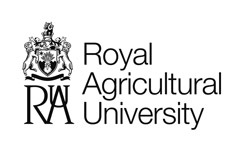Difference between revisions of "Royal Agricultural University"
(Redirected page to Royal Agricultural College) |
(unstub) Tag: Removed redirect |
||
| Line 1: | Line 1: | ||
| − | + | {{group | |
| + | |wikipedia=https://en.wikipedia.org/wiki/Royal_Agricultural_University | ||
| + | |spartacus= | ||
| + | |constitutes=University | ||
| + | |start=1845 | ||
| + | |logo=Royal Agricultural University logo.jpg | ||
| + | |headquarters=Cirencester, Gloucestershire, England | ||
| + | |type=Public | ||
| + | |description=The first agricultural college in the English-speaking world. | ||
| + | |website=http://www.rau.ac.uk/ | ||
| + | |motto=Latin: Avorum Cultus Pecorumque, "Caring for the Fields and the Beasts" | ||
| + | }} | ||
| + | The '''Royal Agricultural University''' (RAU), formerly the '''Royal Agricultural College''', is a university in Cirencester, Gloucestershire, England. Established in 1845, it was the first agricultural college in the English-speaking world.<ref>https://web.archive.org/web/20151117021056/http://www.rau.ac.uk/the-rau/history-heritage</ref> | ||
| + | |||
| + | ==History== | ||
| + | The Royal Agricultural University was founded as the Royal Agricultural College in 1842,<ref>The American Journal of Education, Volume 22, [[Henry Barnard]], F.C. Brownell, 1871</ref> at a meeting of the Fairford and Cirencester Farmers’ Club. Concerned by the lack of government support for education, Robert Jeffreys-Brown addressed the meeting on "The Advantages of a Specific Education for Agricultural Pursuits".<ref>The History of the Royal Agricultural College, Cirencester Roger Sayce, p.1</ref> A prospectus was circulated, a general committee was appointed and [[Henry Bathurst, 4th Earl Bathurst]] was elected president. Funds were raised by public subscription: much of the support came from the wealthy landowners and farmers of the day, and there was no government support. Construction of the main building, in Victorian Tudor style, began in April 1845 and was designed by [[Samuel Daukes|S. W. Daukes]] and [[John R. Hamilton (architect)|John R. Hamilton]], and built by Thomas Bridges of Cirencester.<ref name="NHLE">https://historicengland.org.uk/listing/the-list/list-entry/1187418</ref> The first 25 students were admitted to the college in September 1845. | ||
| + | |||
| + | [[Queen Victoria]] granted a [[royal charter]] to the college in 1845 and sovereigns have been patrons ever since, visiting the college in every reign. [[Prince Charles]] became president in 1982. | ||
| + | |||
| + | The college gained full [[university status]] in 2013 and changed its name accordingly.<ref>https://web.archive.org/web/20141017020314/http://www.bbc.co.uk/news/education-2046401</ref> | ||
| + | |||
| + | |||
| + | {{SMWDocs}} | ||
| + | ==References== | ||
| + | {{reflist}} | ||
Latest revision as of 12:10, 30 August 2022
(University) | |
|---|---|
 | |
| Motto | Latin: Avorum Cultus Pecorumque, "Caring for the Fields and the Beasts" |
| Formation | 1845 |
| Headquarters | Cirencester, Gloucestershire, England |
| Type | Public |
| The first agricultural college in the English-speaking world. | |
The Royal Agricultural University (RAU), formerly the Royal Agricultural College, is a university in Cirencester, Gloucestershire, England. Established in 1845, it was the first agricultural college in the English-speaking world.[1]
History
The Royal Agricultural University was founded as the Royal Agricultural College in 1842,[2] at a meeting of the Fairford and Cirencester Farmers’ Club. Concerned by the lack of government support for education, Robert Jeffreys-Brown addressed the meeting on "The Advantages of a Specific Education for Agricultural Pursuits".[3] A prospectus was circulated, a general committee was appointed and Henry Bathurst, 4th Earl Bathurst was elected president. Funds were raised by public subscription: much of the support came from the wealthy landowners and farmers of the day, and there was no government support. Construction of the main building, in Victorian Tudor style, began in April 1845 and was designed by S. W. Daukes and John R. Hamilton, and built by Thomas Bridges of Cirencester.[4] The first 25 students were admitted to the college in September 1845.
Queen Victoria granted a royal charter to the college in 1845 and sovereigns have been patrons ever since, visiting the college in every reign. Prince Charles became president in 1982.
The college gained full university status in 2013 and changed its name accordingly.[5]
Alumni on Wikispooks
| Person | Born | Died | Nationality | Summary | Description |
|---|---|---|---|---|---|
| Stuart Agnew | 30 August 1949 | Politician | A member of the European Parliament | ||
| Ross Ashcroft | 3 October 1977 | Filmmaker Broadcaster Businessperson | |||
| Geoffrey Clifton-Brown | 23 March 1953 | UK | Politician | ||
| Simon Coveney | 16 June 1972 | Eire | Politician | Single Bilderberger Irish politician | |
| Charles Henry Plumb | 27 March 1925 | 15 April 2022 | British banker businessman and lobbyist |
References
- ↑ https://web.archive.org/web/20151117021056/http://www.rau.ac.uk/the-rau/history-heritage
- ↑ The American Journal of Education, Volume 22, Henry Barnard, F.C. Brownell, 1871
- ↑ The History of the Royal Agricultural College, Cirencester Roger Sayce, p.1
- ↑ https://historicengland.org.uk/listing/the-list/list-entry/1187418
- ↑ https://web.archive.org/web/20141017020314/http://www.bbc.co.uk/news/education-2046401